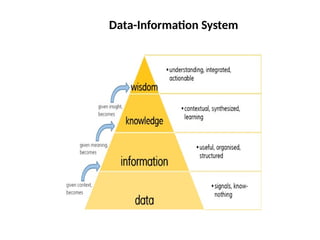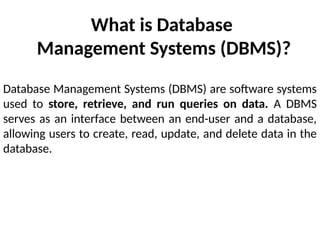Ad
Basic of Database Management System(DBMS)
- 3. Data... data is raw. It simply exists and has no significance beyond its existence (in and of itself). It can exist in any form, usable or not. It does not have meaning of itself.
- 4. information is data that has been given meaning by way of relational connection. This "meaning" can be useful, but does not have to be. In computer parlance, a relational database makes information from the data stored within it.
- 6. Definition: The ability to make sound judgments and decisions based on knowledge and experience. Characteristics: Wisdom involves a deep understanding of the underlying principles and the ability to apply knowledge in a practical and meaningful way. Example: Knowing when and how to use one's knowledge of the alphabet ('I') to communicate effectively and persuasively.
- 7. What is Database? •A database approach is a well-organized collection of data that are related in a meaningful way which can be accessed by different users but stored only once in a system. The various operations performed by the DBMS system are: Insertion, deletion, selection, sorting etc •Databases are designed to facilitate the organization and manipulation of large volumes of data, making it easier to store, retrieve, update, and manage information. •It can be managed through a Database Management System (DBMS), a software used to manage data. Database refers to related data in a structured
- 8. Types of Databases Relational databases • Relational databases have been around since the 1970s. The name comes from the way that data is stored in multiple, related tables. Within the tables, data is stored in rows and columns. • The relational database management system (RDBMS) is the program that allows you to create, update, and administer a relational database. • Structured Query Language (SQL) is the most common language for reading, creating, updating and deleting data. Relational databases are very reliable.
- 9. • They are compliant with ACID (Atomicity, Consistency, Isolation, Durability), which is a standard set of properties for reliable database transactions. • Relational databases work well with structured data. Organizations that have a lot of unstructured or semi-structured data should not be considering a relational database. Examples: Microsoft SQL Server, Oracle Database, MySQL, PostgreSQL and IBM Db2
- 10. NoSQL databases • NoSQL is a broad category that includes any database that doesn’t use SQL as its primary data access language. • These types of databases are also sometimes referred to as non- relational databases. Unlike in relational databases, data in a NoSQL database doesn’t have to conform to a pre-defined schema, so these types of databases are great for organizations seeking to store unstructured or semi-structured data. • One advantage of NoSQL databases is that developers can make changes to the database on the fly, without affecting applications that are using the database. Examples: Apache Cassandra, MongoDB, CouchDB, and CouchBase
- 11. Cloud databases A cloud database refers to any database that’s designed to run in the cloud. Like other cloud-based applications, cloud databases offer flexibility and scalability, along with high availability. Cloud databases are also often low-maintenance, since many are offered via a SaaS model. Examples: Microsoft Azure SQL Database, Amazon Relational Database Service, Oracle Autonomous Database.
- 12. Object-oriented databases An object-oriented database is based on object-oriented programming, so data and all of its attributes, are tied together as an object. Object- oriented databases are managed by object-oriented database management systems (OODBMS). These databases work well with object-oriented programming languages, such as C++ and Java. Like relational databases, object- oriented databases conform to ACID standards. Examples: Wakanda, ObjectStore
- 13. Key-value databases One of the simplest types of NoSQL databases, key-value databases save data as a group of key-value pairs made up of two data items each. They’re also sometimes referred to as a key-value store. Key-value databases are highly scalable and can handle high volumes of traffic, making them ideal for processes such as session management for web applications, user sessions for massive multi- player online games, and online shopping carts. Examples: Amazon DynamoDB, Redis
- 14. What is Database Management Systems (DBMS)? Database Management Systems (DBMS) are software systems used to store, retrieve, and run queries on data. A DBMS serves as an interface between an end-user and a database, allowing users to create, read, update, and delete data in the database.
- 16. What is Database Management System (DBMS)? • Collection of interrelated data • Set of programs to access the data • It provides a convenient and efficient way to store, retrieve and modify information. • Application programs request DBMS to retrieve, modify/insert/delete data for them and thus it acts as a layer of abstraction between the application programs and the file system.
- 19. Data modelling: A DBMS provides tools for creating and modifying data models, which define the structure and relationships of the data in a database. Data storage and retrieval: A DBMS is responsible for storing and retrieving data from the database, and can provide various methods for searching and querying the data. Concurrency control: A DBMS provides mechanisms for controlling concurrent access to the database, to ensure that multiple users can access the data without conflicting with each other. Data integrity and security: A DBMS provides tools for enforcing data integrity and security constraints, such as constraints on the values of data and access controls that restrict who can access the data. Key Features of DBMS
- 20. Backup and recovery: A DBMS provides mechanisms for backing up and recovering the data in the event of a system failure. DBMS can be classified into two types: Relational Database Management System (RDBMS) and Non-Relational Database Management System (NoSQL or Non-SQL) RDBMS: Data is organized in the form of tables and each table has a set of rows and columns. The data are related to each other through primary and foreign keys. NoSQL: Data is organized in the form of key-value pairs, documents, graphs, or column-based. These are designed to handle large-scale, high-performance scenarios.
- 21. File System Approach •The file system is basically a way of arranging the files in a storage medium like a hard disk. •The file system organizes the files and helps in the retrieval of files when they are required. •File systems consist of different files which are grouped into directories. The directories further contain other folders and files. The file system performs basic operations like management, file naming, giving access rules, etc.
- 23. Difference between File System and DBMS Basics File System DBMS Structure The file system is a way of arranging the files in a storage medium within a computer. DBMS is software for managing the database. Data Redundancy Redundant data can be present in a file system. In DBMS there is no redundant data. Backup and Recovery It doesn’t provide Inbuilt mechanism for backup and recovery of data if it is lost. It provides in house tools for backup and recovery of data even if it is lost.
- 24. Query processing There is no efficient query processing in the file system. Efficient query processing is there in DBMS. Consistency There is less data consistency in the file system. There is more data consistency because of the process of normalization. Complexity It is less complex as compared to DBMS. It has more complexity in handling as compared to the file system. Security Constraints File systems provide less security in comparison to DBMS. DBMS has more security mechanisms as compared to file systems. Attributes To access data in a file , user requires attributes such as file name, file location. No such attributes are required.
- 25. Data Independence There is no data independence. In DBMS data independence exists, mainly of two types: 1) Logical Data Independence. 2)Physical Data Independence. User Access Only one user can access data at a time. Multiple users can access data at a time. Sharing Data is distributed in many files. So, it is not easy to share data. Due to centralized nature data sharing is easy Integrity Constraints Integrity Constraints are difficult to implement Integrity constraints are easy to implement
- 26. DATABASE APPLICATIONS: – Banking: all transactions – Airlines: reservations, schedules – Universities: registration, grades – Sales: customers, products, purchases – Online retailers: order tracking, customized recommendations – Manufacturing: production, inventory, orders, supply chain – Human resources: employee records, salaries, tax deductions
- 28. Let us discuss the components one by one clearly. Hardware The hardware is the actual computer system used for keeping and accessing the database. The conventional DBMS hardware consists of secondary storage devices such as hard disks. Databases run on the range of machines from micro computers to mainframes. Software Software is the actual DBMS between the physical database and the users of the system. All the requests from the user for accessing the database are handled by DBMS.
- 29. Data It is an important component of the database management system. The main task of DBMS is to process the data. Databases are used to store the data, retrieved, and updated to and from the databases. Users There are a number of users who can access or retrieve the data on demand using the application and the interfaces provided by the DBMS.
- 30. Procedures Procedures refer to general instructions to use a database management system. This includes procedures to set up and install a DBMS, To login and logout of DBMS software, manage databases, take backups, generate reports etc. Database Access Language Database Access Language is a simple language that allows users to write commands to perform the desired operations on the data that is stored in the database. Database Access Language is a language used to write commands to access, insert, and delete data stored in a database. Examples of database languages are SQL(structured query language)

































































































